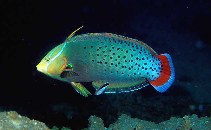| Family: |
Labridae (Wrasses), subfamily: Corinae |
| Max. size: |
60 cm TL (male/unsexed) |
| Environment: |
reef-associated; marine; depth range - 20 m |
| Distribution: |
Western Indian Ocean: southern Red Sea to Natal, South Africa and east to Sri Lanka. |
| Diagnosis: |
Dorsal spines (total): 9-9; Dorsal soft rays (total): 12-12; Anal spines: 3-3; Anal soft rays: 12-12. Terminal males reddish to lavender in color; caudal with small, dark-edged, blue-green spots, posterior margin light orange-red (Ref. 4392). Juveniles orange, head and lower part of body dark brown; 3 large, vertically elongate, broadly black-edged, white spots on dorsal part of body (Ref. 4392). |
| Biology: |
Adults found in weed, rock and coral areas; juveniles in shallow tide pools (Ref. 30573). Generally solitary (Ref. 5213). Feeds mainly on hard-shelled prey, including crustaceans, mollusks and sea urchins (Ref. 5374). Young very different (Ref. 1623). |
| IUCN Red List Status: |
Least Concern (LC); Date assessed: 22 February 2009 Ref. (130435)
|
| Threat to humans: |
harmless |
Source and more info: www.fishbase.org. For personal, classroom, and other internal use only. Not for publication.

